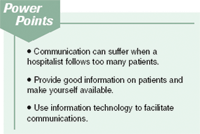Article
Hospitalists: Communication is key
They can do a much better job keeping you informed, but they need your help.
Internist Charles E. Meidt, a hospitalist at Bryn Mawr Hospital in Bryn Mawr, PA, is discharging an 80-year-old woman who was admitted four days ago with an exacerbation of her COPD. He'd tried unsuccessfully to contact her primary physician at 8 a.m. and left a message for the doctor to call him back. When Meidt hasn't heard from him by 12:30, he calls the office again. This time, he's told the doctor is on vacation but is due back the next day.
Meidt goes to the patient's room and gives her discharge instructions. He explains that a visiting nurse will come to her home to draw blood. He also tells her how much oxygen to use and how to taper off of her prednisone. Finally, he says that she should call her doctor the next day to have her Coumadin dose adjusted. (She's on the blood thinner for atrial fibrillation.) If she can't reach her physician, he emphasizes, she should call Meidt at the hospital.

Of course, referring physicians also see some problems with communication from hospitalists. David L. Boles, a family physician in Nashville, says that a new hospitalist program to which he refers patients has had spottier communication with him than a better-established program at another hospital. "With the new program, if certain doctors are involved, it's great; if others are involved, it's poor," he says.
Communication problems vary with caseload
The importance of communications with hospitalists has grown with the exponential increase in their use. The Society of Hospital Medicine estimates that there are now about 12,000 hospitalists; it predicts there will be 30,000 by the end of the decade. Forty-five percent of hospitals with 100 or more beds now host hospitalist programs, and a much higher percentage of larger hospitals do. About one-third of hospitalists were employed directly by hospitals or their affiliated entities in 2003, according to an SHM survey. Another 25 percent were in hospitalist-only groups, including multistate companies and local physician groups. Academic hospital medicine programs employed 25 percent of hospitalists, and 16 percent belonged to multispecialty groups.
Who employs the hospitalist may have an impact on the level of communication with referring doctors. For example, hospitals employ or contract with hospitalists partly to reduce the length of stay; if that's the dominant motivation, communication may not be a top priority and continuity of care may suffer, says internist Robert Berenson, a health policy expert at the Urban Institute.
Communication is certainly at risk when hospitalists are following too many patients. "If it's a choice between making sure they're doing the right things for the patient and communicating with primary care doctors, communication may be seen as expendable," says internist Robert M. Wachter, a professor of medicine at the University of California San Francisco School of Medicine and a leading expert on hospitalists.
To be effective, says Wachter, a hospitalist should follow no more than 15 patients at a time. He worries about those services on which hospitalists are caring for 20 to 30 patients. "Anecdotally, I tend to hear this a little more from hospitalists who are working for private companies or for themselves."





